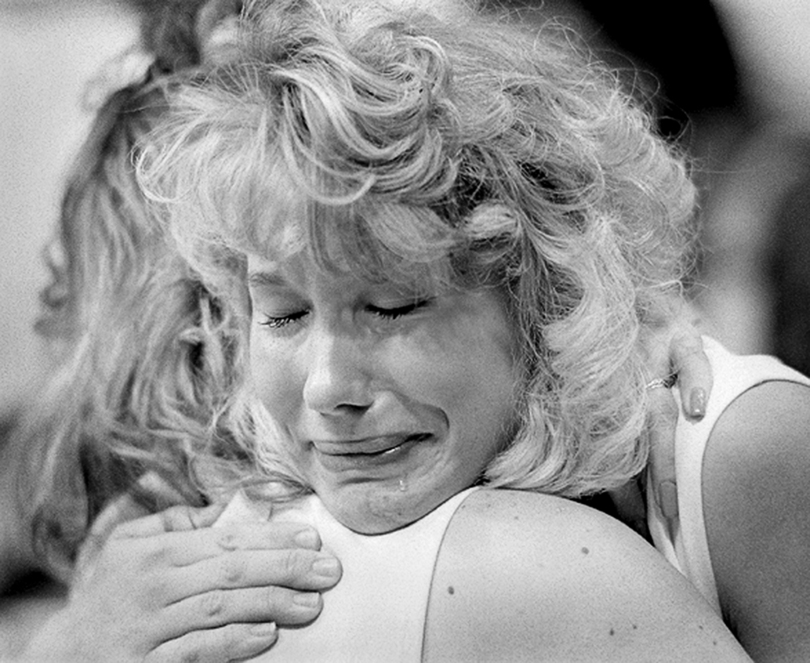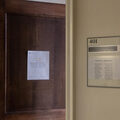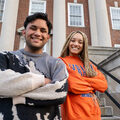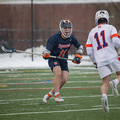C
atherine Hauschild, then Catherine Crossland, an SU sophomore, walked into Flint Hall in a hurry on Dec. 21, 1988. It was between 4 and 5 p.m., and she had just finished a class. She rushed in, needing to change into her white top and orange-and-blue skirt cheerleader uniform before heading to the Carrier Dome for a basketball game.
On the way to her room, Hauschild ran into a resident adviser near the front desk. The RA was the first to tell her a plane — that had taken off in Frankfurt, Germany; stopped in London; and was on its way to New York City and then Detroit — had exploded above Lockerbie, Scotland, from what investigators later found to be a bomb in a suitcase.
The RA had heard SU students might have been involved, but nothing was for sure. Details had only started trickling in. Hauschild knew two other cheerleaders studying abroad in Europe, so she ran up to her room to turn on the news. Her mind raced.
Were they OK?
About an hour earlier, while Hauschild was still in class, a secretary picked up the phone across campus in a building on Euclid Avenue. It was shortly after 3:30 p.m. A student on the other end of the line told the secretary for SU’s Division of International Programs Abroad that a Pan Am plane carrying SU students had gone missing.
Afraid and confused — “How does a plane go missing in the 20th century?” one SU employee wondered — the secretary turned on the TV. The plane was not missing. There, on screen, appeared the names of victims of Flight 103. The secretary was horrified. She knew the office couldn’t confirm to parents that SU students might have been on board. Her phone started ringing.
Walking to the Carrier Dome, Hauschild didn’t know about any of this chaos. Tipoff ticked closer with each minute, and she didn’t have time to worry any more about the explosion after briefly watching the news, which had revealed nothing about her friends. The Dome pulsed with 25,746 people ready to see then-No. 3 Syracuse play Western Michigan. At about 4:30 p.m., just before Hauschild arrived at the Dome, the information trickling out of the SU Abroad office made it to Syracuse Athletics.
SU never seriously considered postponing the game, then-Chancellor Melvin Eggers said, because university administrators were “so busy” and in “such shock” that any thought to do so “just wasn’t acted upon.” Vernon Payne, the then-WMU head coach, later told The Daily Orange his team was prepared to not play, and the Broncos would have had “no problems” if Syracuse had canceled. But Eggers pushed forward. It was a decision he came to regret.
“We recognize the seriousness of the situation,” then-Director of Athletics Jake Crouthamel said. “And it is tragic, there is no question about it. But even under these circumstances, sad as they are, we have a responsibility to our fans.”
So, before the game, Syracuse decided to have the Dome observe a moment of silence.
Standing on the sideline, the enormity of everything unknown overwhelmed Hauschild. She didn’t know then that her two cheerleading friends were safe, that one was traveling Europe and the other had been on the same Pan Am flight route one day earlier. She didn’t know then that her Kappa Kappa Gamma sorority sister, Amy Shapiro, was dead. As the moment of silence ended, Hauschild’s eyes filled with tears.
Amy Jo Eveleigh, a friend and fellow cheerleader, rushed to hold Hauschild, who shut her eyes tightly, lips puckering as tears spilled down her cheeks.
Twenty-nine years after the disaster, Hauschild still sobbed at that memory.
“Everyone was in shock, and I think that’s why I just cried,” she said. “How could you not be emotional? Those were kids that had been in that Dome and on campus, and they weren’t going to come back.”
Eveleigh, now Amy Jo Polly, never forgot that moment, one the word “tragedy” never seemed strong enough for. As she held her friend tight, each of them crying into the other’s shoulder, a photography student raised his camera. It was right then that an unsuspecting Hauschild became Syracuse’s defining image of the Lockerbie bombing.

Catherine Hauschild sits on the front steps of her home in Athens, Ohio, late last month. She has been with Bill Hauschild since 1986, and they got married in 1991. They’ve moved to Oklahoma, New York, Germany and other places for his military assignment. Jacob Gedetsis | Senior Staff Writer
SU
professor Lawrence Mason was wrapping Christmas presents on his dining room table when he received a phone call from Hai Do, then a United Press International state bureau chief of photography. Mason thought his boss, whom he regularly shot Syracuse basketball games for, wanted to wish him happy holidays. Instead, Do told him about the Pan Am flight, and that as many as 40 SU students might have been aboard. Do asked Mason to take photos of a memorial service at Hendricks Chapel.
Mason told Do he couldn’t do it, because he felt uncomfortable being a professional around the students he taught every day grieving. Do understood and instead asked Mason to photograph the atmosphere of the basketball game. Later, as Mason feared, he learned several of his students died in the attack.
Mason and the photography student, David Grunfeld, worked as stringers for the UPI wire service and routinely covered games together. It was assumed that Grunfeld, who was born in Marathon, New York — about 45 minutes south of Syracuse — would take the game photos.
Early in the first half, in a dark room set up inside the Dome, Grunfeld handed a roll of film to Mason from his pregame shoot that included the moment of silence. Mason’s eyes scanned the photos until he froze at the little square frame of Hauschild, whom he recognized immediately. She had been in his class that semester.
They needed to send the photo to the UPI office in New York City as soon as possible — immediately, if possible — but Mason hesitated.
For both teacher and student, the image encapsulated so much that could never be said, but Grunfeld hadn’t had Hauschild’s permission to take her photo. Mason thought at first it was OK to send the photo since it was taken in a public space. Then he countered himself. It was a private moment. The game creeped into the second half.
Years later, many of those at the game remember the Dome as somber and quiet, despite the crowd size. But one Syracuse Herald-Journal column from the game described the Dome as raucous as usual, with fans applauding and howling at the baskets made and missed. Hauschild, for her part, did the only thing she knew to do and cheered.
“(It was like) they weren’t there,” Hauschild said of the crowd. “I almost think that it was good in a sense that everybody wanted to be with other people to try to process it.”
Inside the dark room, Mason needed to decide. The deadline for morning papers fast approached. The Orange eventually won, 94-71.
“This is the biggest story in the world,” Mason said recently. “And if you are going to try to find an illustration to go along with it … (This) was a very strong picture.”
The next morning, Hauschild was walking into Schine Student Center to grab breakfast when she ran into a friend.
“Catherine, have you seen the papers?” he told her. “You are all over the papers.”
Less than three weeks after the attack, Hauschild found herself walking into an airport to travel to Japan, where SU’s cheerleading squad had been chosen to represent the East in an East-West all-star college football game. The university was allowed to send six cheerleaders to the Japan Bowl in Yokohama, and the squad selected five upperclassmen. Of three sophomores, they picked Hauschild for the last spot.
As Hauschild walked onto the plane, she couldn’t shake her uneasy feeling. She worried a bomb lay somewhere nearby, and she regarded everyone suspiciously. Then, as the plane took off, she settled into her seat to fly halfway across the world.








